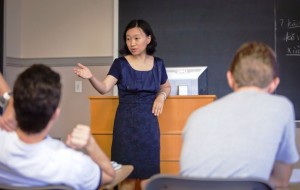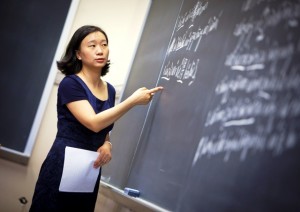
Professor Li Yang teaches a class in Pardee Hall.
Li Yang believes in setting a high bar for her students. And apparently her teaching style pays off. Students in her introductory Chinese course begin class not knowing a single word and end the semester narrating self-portrait videos in the language. As Yang emphasizes to her students, Chinese isn’t impossible to learn.
Yang, assistant professor of Chinese, became Lafayette’s first full-time Chinese professor in 2010. As enrollment in Chinese language and culture classes at the College increases, Yang and her colleagues hope to investigate the possibility of a degree program as well as a minor in Chinese. She has a lot of confidence in her students
“Chinese is one of the few tonal languages in the world,” she says. “It also has a unique writing system. These two aspects make Chinese distinctively different from Western languages, and they post the biggest challenges to American students. Particularly, a lot of Chinese instructors tended to give up on the tones in the United States. I don’t agree with that. I believe every American student can master tones through hard work. I set a high bar. The higher the bar, the higher they can achieve.”
Yang emphasizes tones during daily class exercises by correcting bad tones and affirming correct ones. The more students hear the correct tones, she says, the more likely they will remember them when speaking. She is also keen to analyze the characters and words to facilitate students’ learning. For example, a “tree” character paired with a “person” radical becomes “rest.” If the character “difficult” and the character “to look” are put together, the adjective “ugly” is formed. Along the way, she helps students discover and appreciate the beauty of the Chinese language.

Professor Li Yang
The Chinese program is another step in the College’s efforts to increase the scope of global education. In addition to language classes, Yang enjoys exposing students to Chinese culture. Her own area of research is contemporary Chinese cinema. She’s working on a book manuscript with the working title “Chinese Art Film in the 1990s: Film System, Film Style, and Alternative Film Culture” and plans to use students in her research.
She also hopes that the addition of Chinese to the College’s roster of language offerings will inspire students to take up any language, not just her specialty.
“A strong Chinese program shows the College’s commitment to global education, which will draw students to learn foreign languages in general,” she says. “Foreign language acquisition remains the most effective way to global education. The goal for the Chinese program is to become a premier destination on campus for global education.”
This May, Yang and Ingrid Furniss, assistant professor of art, will lead a trip to China. So far, 16 students have signed up. For those who can’t make the trip, there will be a Chinese house this fall as part of the College’s new Living Learning Communities.
“It is truly an exciting opportunity for Chinese language immersion without leaving the country,” Yang says.
New ideas and ways of thinking are what motivated Yang to become a professor in the first place. In her first year at Peking University of China, where she earned her bachelor’s degree, one of her professors challenged her view that arranged marriage is inherently wrong. As the Chinese government had abolished it as part of a modernization effort, she always took for granted that it should be that way. Discussions like that one as well as classes she took at the University of Texas, Austin, where she earned master’s and Ph.D. degrees, left her fascinated by exploring ideas from different angles.
“I am inspired every day by the new ideas I discover from my students and other scholars,” she says.

